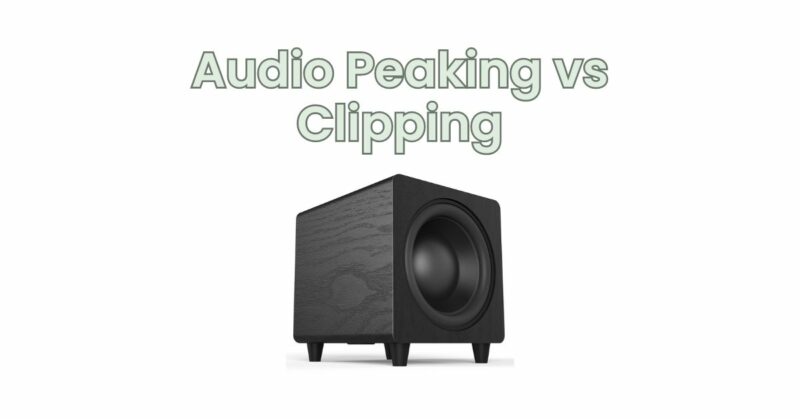In the world of audio, terms like peaking and clipping are often used to describe different types of distortion that can occur in audio signals. While they may sound similar, peaking and clipping have distinct characteristics and effects on sound quality. In this article, we will explore the differences between audio peaking and clipping, their causes, and the impact they have on audio signals.
- Understanding Audio Peaking: Audio peaking refers to the phenomenon where the audio signal reaches its maximum level without distortion, but the waveform exhibits a rounded or peaked shape. Peaking occurs when the signal level approaches the maximum limit, resulting in a smooth compression of the waveform’s peaks. While peaking does not introduce distortion, it indicates that the audio signal is approaching its maximum capacity and may require attention to prevent clipping.
- Understanding Audio Clipping: Audio clipping, on the other hand, occurs when the audio signal exceeds the maximum level that the system or equipment can handle. When a signal is clipped, the waveform is cut off at the maximum limit, resulting in a distorted and flattened appearance. Clipping can occur due to various factors, including an overloaded amplifier, improper gain settings, or excessive input levels. Clipped audio signals often sound harsh and distorted, adversely affecting the overall audio quality.
- Causes and Effects of Peaking: Peaking can be caused by several factors, including: a. Signal dynamics: Transient peaks or sudden bursts of sound in the audio signal can cause temporary peaking. b. Improper gain staging: Inadequate gain structure or improper level balancing between audio components can lead to peaking. c. Overprocessing: Applying excessive compression or equalization to the audio signal can cause peaking.
Peaking can have different effects on sound quality: a. Reduced headroom: Peaking limits the available headroom, potentially leading to a loss of dynamic range in the audio signal. b. Increased risk of clipping: Peaking signals are closer to the maximum limit, increasing the likelihood of clipping if the signal level continues to rise.
- Causes and Effects of Clipping: Audio clipping can occur due to various factors: a. Overloaded amplifier: Driving an amplifier beyond its maximum capacity can cause the signal to clip. b. Improper gain settings: Setting the gain levels too high in the audio chain can result in clipping. c. Excessive input levels: Feeding an audio signal with levels that exceed the equipment’s input capabilities can cause clipping.
Clipping has several noticeable effects on sound quality: a. Distortion: Clipped audio signals exhibit distortion, resulting in a harsh, unpleasant sound. b. Loss of detail: Clipping removes the subtle nuances and dynamics in the audio signal, leading to a loss of detail and clarity. c. Speaker damage risk: Prolonged exposure to clipped signals can damage speakers and other audio equipment due to excessive heat and stress.
- Preventing and Managing Peaking and Clipping: To prevent or manage peaking and clipping, consider the following steps: a. Proper gain staging: Set appropriate gain levels at each stage of the audio chain to maintain optimal signal levels and prevent both peaking and clipping. b. Use limiters and compressors: Employ limiters or compressors to control peaks and prevent signal clipping. c. Monitor signal levels: Regularly monitor signal levels using visual meters or audio interfaces to ensure they stay within safe limits. d. Adjust input levels: If the audio signal is too hot or exceeds the equipment’s input capacity, adjust the input levels accordingly. e. Choose high-quality equipment: Invest in high-quality audio components and amplifiers that can handle higher signal levels without distortion or clipping.
Understanding the differences between audio peaking and clipping is crucial for maintaining optimal sound quality. Peaking refers to rounded waveform peaks near the maximum level without distortion, while clipping occurs when the signal exceeds the equipment’s handling capacity, resulting in distorted and flattened waveforms. Both peaking and clipping have distinct causes and effects on sound quality, ranging from reduced headroom and increased risk of clipping to distortion and loss of detail. By following proper gain staging techniques, using limiters and compressors, and monitoring signal levels, you can effectively prevent and manage peaking and clipping, ensuring clean and undistorted audio reproduction.


